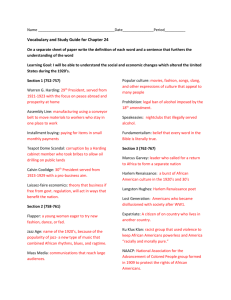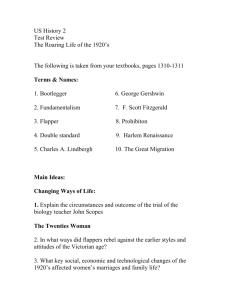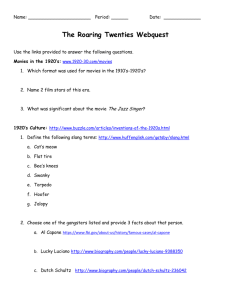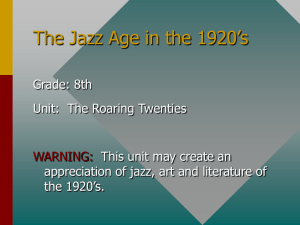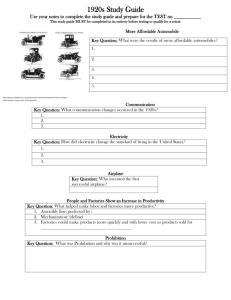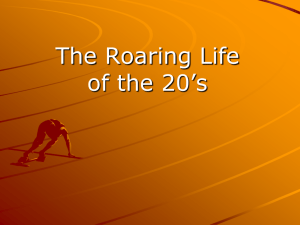Chapter 21 Slides
advertisement
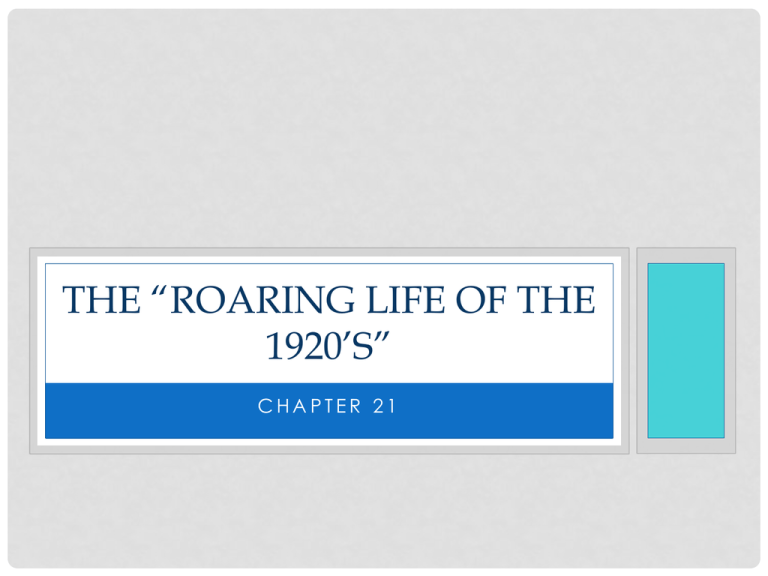
THE “ROARING LIFE OF THE 1920’S” CHAPTER 21 MAIN IDEA • Americans experienced cultural conflicts as customs and values change in the 1920’s. CHANGING WAYS OF LIFE • The 1920 census revealed that for the first time more Americans lived in towns and cities than in the country. • The 1920’s sped the process of urbanization. • New York, Chicago, Philadelphia became huge cities, and 65 others had more than 100,000 people. • As 2 million people a year left their farms, city values—not small town values—began to dominate the nation. • This transition was not always easy. CHANGING WAYS OF LIFE • One clash concerned Prohibition, favored by many rural people and opposed by many city dwellers. • In 1920, the 18th Amendment to the Constitution took effect and Prohibition became law. • However, the government did not have enough law officers to enforce the laws. • Illegal nightclubs sprang up all over the country. URBAN LIFE CONTINUED… • People began making their own illegal liquor. • Others bought from “bootleggers” resulting in large sums of money flowing into organized crime. • By the middle of the decade, only 19% of Americans supported prohibition. • But, it remained a law till 1933 PROHIBITION CHANGING WAYS OF LIFE • The country also saw a revival of Christian fundamentalism. • They believed every word in the bible was literally true. • Religious revivals and preachers drew large crowd, especially in the South and West. CHANGING WAYS OF LIFE • Soon, fundamentalist clashed with science in the “Scoops Trial”. • What was this? Page 644 THE TWENTIES WOMAN—SECTION 2 • Main Idea: American women pursued new lifestyles and new jobs and different roles in society during the 1920’s. THE TWENTIES WOMAN • The new urban culture influenced many women to demand greater freedom, symbolized by the “Flapper”. • These young women wore shorter skirts, shorter hair, and more jewelry than was customary at the time. • They smoked cigarettes and drank alcohol. • Not all women took on this new identity, but many felt caught between the “old” and the “new”. FLAPPERS THE TWENTIES WOMAN • Many women across America were adopting new roles at work. • Many women worked outside the home than before the war. They took on many different jobs. • Teachers, nurses, secretaries, or sales clerks. • Wherever they worked, though, women faced discrimination. • The 1920’s began trends that continue today; identifying jobs as either a woman’s or a man’s. • They were also paid less then men. THE TWENTIES WOMAN • Most married women still did not enter the workforce. • Those who did, found it difficult to balance the demands of both job and family. • Women also faced changes in the home. • They were having fewer children. • More shopping outside the home. • So “ready made” clothes and labor saving devices made housework easier and provided more free time. OTHER CHANGES AFFECTING FAMILIES • Marriages were more often the result of the two partners choice, not their parent’s arrangements. • More teenagers stayed in school than before. • But, teenagers were starting to become more rebellious. EDUCATION AND POPULAR CULTURE SECTION 3 • Main Idea: The mass media, movies, and spectator sports played important roles in creating popular culture of the 1920’s—a culture that many artists and writers critiqued. EDUCATION AND POPULAR CULTURE • With prosperity and the need for a more educated workforce, more students received a high school education. • High Schools changed though: • • • Offered vocational training for future workers and home economics for future homemakers. Educators met the challenge of teaching millions of children of immigrants, many of whom did not know English. As a result, an increasing amount of people could read— with these increased demands, schooling costs rose dramatically. EDUCATION AND POPULAR CULTURE • American tastes were shaped by mass media. • The number of people who read the newspaper increased sharply and national magazines flourished. • Radio became the most powerful form of mass media. • It grew into national networks that offered programming to millions. RADIO EDUCATION AND POPULAR CULTURE • Americans by the 1000’s found entertainment in movie theaters. • For most of the decade, the movies were silent. • In 1927, Hollywood released the “Jazz Singer”—the first major talking picture. • Movies, like magazines and radio, helped create a new national “culture”. “JAZZ SINGER” EDUCATION AND POPULAR CULTURE • Many artists contributed to a flowering of American culture. • Playwright Eugene O’Neil dramatized family conflicts. • Composer George Gershwin wrote music that combined jazz rhythms with classical forms. • Sinclair Lewis, the first American to win a Nobel Prize in literature, wrote best-selling novels taking a critical look at the shallow life of the middle-class. • F. Scott Fitzgerald’s novels showed the dark underside of the flashy life of the 1920s. • Dorothy Parker, Edith Wharton, and other women writers added a unique perspective in their work. F. SCOTT FITZGERALD THE HARLEM RENAISSANCE SECTION 4 • Main Idea: • African American ideas, politics, art, literature, and music flourish in Harlem and elsewhere in the United States. HARLEM RENAISSANCE ART THE HARLEM RENAISSANCE • In the 1920s, hundreds of thousands of African Americans moved to the cities of the North. • Many left the South in search of jobs. • By 1929, 40% of all African Americans lived in cities. • Racial Riots erupted in the North, however. THE HARLEM RENAISSANCE • W.E.B. Du Bois, President of the NAACP protested racial violence. • Another NAACP official, James Weldon Johnson spearheaded an organization’s effort to get Congress to pass a law to put an end to the lynching of African Americans. • While the law never passed, the number of lynching's did decrease. THE HARLEM RENAISSANCE • Marcus Garvey voiced a message of “black pride” that appealed to many African Americans. • Garvey promoted the formation of black-owned businesses. • He also urged many African Americans to return to Africa. THE HARLEM RENAISSANCE • Harlem, a section of New York City, became home to a flowering of African American culture called— the Harlem Renaissance. • Writers Claude McKay, Langston Hughes, and Zora Neale Hurston wrote moving poems, plays, and novels portraying the difficulties and pleasures of black life. • Paul Robeson won renown as an actor. • Musicians Louis Armstrong, “Duke” Ellington, and Bessie Smith delighted audiences with jazz and blues. THE ROARING TWENTIES • The Roaring 20’s was a great decade, filled with social and cultural change. Soon, though, this would all be overshadowed by an economic crash.
